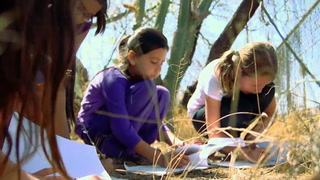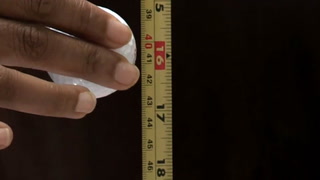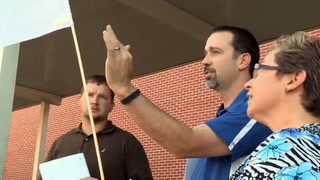NGSS: A Vision for K-12 Science Education Transcript
Speaker 1: When we learn things, it isn’t for memorizing a piece of information, just reciting science facts or principles. It’s not what we want children to be able to do. We want them to be able to go out in the world and make sense of novel phenomena. So, making sense of things really is engaging in a performance and saying, “I need to construct an explanation of why or how this occurs."
Speaker 2: Okay. Let’s get started. Throughout the few days, I want you engaged as the scientist, you as the student, you as the learner.
Speaker 3: If it was room-temperature water, would it be behaving in the same way?
Speaker 4: What’s the science behind this? What’s happening?
As teachers start focusing on the Next Generation Science Standards, they will be able to help students see science as it really is, that it’s not just a set of steps and procedures.
Speaker 1: The real hope is that they can make a connection between what we do in the modeling of performances of science and what they do in their classroom.
Speaker 2: In this day and age, one of the factors influencing the Next Generation Science Standards is the globalization - understanding we’re in a global community. We’re not kind of an isolated entity here.
Speaker 1: The Next Generation Science Standards takes a vision from the framework for K-12 science education and puts it into a set of performance expectations. And it calls for the students to actively engage in science. It sets out parameters for science education, clear goals along with describing the three dimensions that students can engage in to make sense of science.
The three dimensions are the crosscutting concepts, the science and engineering practices, and the disciplinary core ideas.
Speaker 2: Most of those ideas are not new. The integration of them, pulling those three dimensions together, is new.
Speaker 5: If we’re going to have the kids doing that, instruction has to reflect that.
Speaker 6: What I’m walking away from today, kind of a big shift for me is we can focus in on something very specific to help teach a much broader, bigger idea; that it actually helps the students to be able to do that application to new scenarios, new situations.
Speaker 7: Crosscutting concepts - there are seven of them. And the way we’ve organized them is around causality; structure and function; systems; scale and proportion; change in stability; matter and energy; and then the last thing, pattern. These crosscutting concepts are tools that you provide to the children, and they use those tools to make sense of phenomena.
Speaker 1: The crosscutting concepts are a way of organizing the phenomena in terms of what the system is that’s being studied.
Speaker 8: What did you define as your system?
Speaker 9: We included in our system also the surrounding air.
Speaker 1: The idea that there’s a cause-effect relationship.
Speaker 10: What’s causing the cloudiness?
Speaker 11: What’s causing the bubbles to come off of the ice?
Speaker 12: It’s going to get pushed in the direction of the wind - right?
Speaker 1: And, finally, patterns used as evidence to support their explanations.
Speaker 13: So, to me, the pattern is just the fluttering back and forth - right? Do you have a question in mind?
Speaker 14: Why that pattern, that -
Speaker 13: The back and forth?
Speaker 14: - back-and-forth pattern?
Speaker 13: Yeah.
Speaker 15: What if we change the direction of the flag. if we turn it this way?
Speaker 13: Okay. I want to go inside and make a little paper flag that we can blow on and manipulate.
Speaker 1: The practices are a set of things that children do engaging in science performances.
Speaker 16: Asking questions right here - that’s what students do. As a professional teacher, you have to create an environment in which students are asking questions to help them make sense of things.
Speaker 17: Ready?
Speaker 18: 150.
Speaker 17: Why doesn’t that ball return to that exact, same level that you dropped it?
Speaker 4: Engaging students in the practices really does pique their curiosity, and it helps them have a desire to go out and have more questions about the world, which - asking questions is a practice. So, it’s something we want them to be able to do and to be able to discover more about the world.
Speaker 17: What else contributes to it not reaching its maximum height that it started at?
Speaker 19: The pull of gravity. Gravity is still pulling it back down even though it’s bouncing up.
Speaker 20: As learners, using evidence and using that evidence to construct explanations is important. I think having those experiences will really help students own the content.
Speaker 19: More bounce. More energy in the bounce. And that’s really the kinetic energy.
Speaker 1: The last dimension are the core ideas, and there’s nothing new here. We don’t want kids at the end of instruction to recite the core ideas. We want them to use them in science performances to make sense of novel phenomena, applying them to construct explanations and develop arguments.
Speaker 21: So, the alcohol is less dense than the ice. You can see. The density in them is different.
Speaker 22: Oh, yeah. Yeah.
Speaker 1: The core ideas in particular become valuable because we revisit them through every grade band. And they’re moving forward in a very logical way.
Speaker 23: Those things we’re asking them to do can be applied to more than just alcohol and water. It can be applied to cloud formation. It can be applied to condensation.
Speaker 24: Why? What’s happening?
Speaker 25: I think what’s exciting about the Next Generation Science Standards is this intersection of the three dimensions and that we’re not just working on practices one day. You really are infusing the three dimensions within the classroom.
Speaker 26: One of the things that you’ve done is ask "what if?" By doing that, I have to be able to take what I know, what I’ve learned, looking at the models, looking at patterns, and applying them somehow to show that I understand what would happen if I change the dynamic.
Speaker 27: It’s been real helpful to remember that, you know, I can’t do one without thinking about the other.
Speaker 28: No change. We should add that - right?
Speaker 27: That’s how students are going to be thinking about them as well.
Speaker 29: Execute.
Speaker 1: It's my hope that this will be the reform in science education that not only gets students more proficient in science, but builds interest in science.












19 Comments
Sophia Cunningham Aug 27, 2021 2:01pm
How do the NGSS represent a shift in science education?
NGSS represents a shift in science education because the ownership is on the students. Self-discovery. The goal is for students to see how science really is and not just steps and procedures.
What do the teachers in this video learn from engaging with the NGSS?
The teachers learn that it's important for students to continue to ask questions and being actively engaged.
How do the three dimensions work together?
The three dimensions work together (to be continued)
The three dimensions work together
Krystal Melendez Aug 27, 2021 1:13pm
1. NGSS represents a shift in science education because students are activelly engaged in science, the goals of science education are clear, there are both knowledge and skill components, and it ties science into all other subjects instead of keeping it isolated.
2. After engaging in NGSS, the teachers in this video learn that they can engage in several specific tasks to teach something more broader, it helps the students apply the skills they learn to multiple things, and helps peak their curiousity.
3. The 3 dimensions work together by each piece being required in order to help students investigate a concept or complete a task. All 3 are part of the process of science inquiry.
Kimberly Uppleger Jan 12, 2021 5:40pm
Interesting how this is now heading towards a STEAM approach of learning. It makes students feel like they have accomplished something by exploring on their own and not just being lectured to.
Cami Crow Jun 9, 2020 1:09pm
How do the NGSS represent a shift in science education: Its a new way of learning that teaches students to study something and figure out how it works. Insead of reading about something or watching a video, they discover on their own.
What do the teachers in this video learn from engaging with the NGSS? They learn to use inquiry to determine how something works. This helps them to see how thier own students can benefit and learn from this style of teaching.
How do the three dimensions work together? They work together to help students focus on one idea, that actually teaches them many different things. They can relate the one idea to different topics.
Olivia Hobson Apr 8, 2019 7:14pm